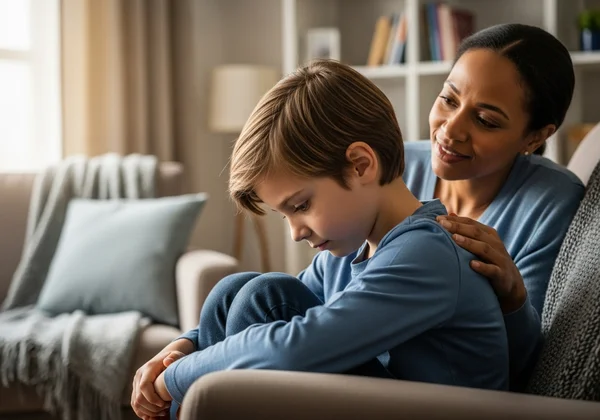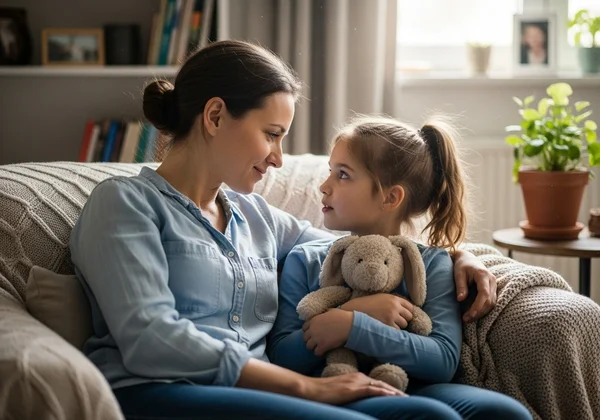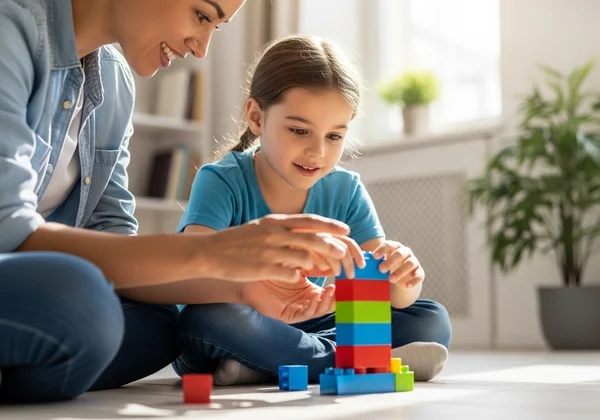Childhood Trauma Test & Guidance: How to Talk to Kids About Trauma
As a parent or caregiver, your child's well-being is your highest priority. So when you notice changes in their behavior—perhaps they've become more withdrawn, easily startled, or are struggling with big, unexplainable emotions—it’s natural to feel a deep sense of concern. You may suspect a difficult or overwhelming event is the cause, but the path forward can feel uncertain. You might be wondering, How do I know if I have trauma, or more accurately, how do I know if my child does? Learning how to talk to kids about trauma is one of the most courageous and loving steps you can take.
This guide offers compassionate, practical advice to help you open a safe and validating conversation. It’s about creating a space for understanding, not interrogation. By approaching this topic with gentleness and care, you can empower your child on their path to healing and strengthen your connection along the way. If you're seeking a starting point to better understand what your child might be experiencing, our resources can help gain some clarity.

Recognizing Signs of Trauma in Your Child
Before you can start a conversation, it’s helpful to understand what you’re seeing. Trauma doesn’t look the same in every child, and its signs can often be mistaken for simple behavioral issues. Recognizing these patterns is the first step toward offering the right support.
Common Behavioral Changes to Observe
Observing child behavior after trauma is key. You know your child best, so even subtle shifts in their typical patterns can be significant. Look for sudden or dramatic changes, such as a child who was once outgoing becoming socially withdrawn or a typically calm child having frequent, intense outbursts.
Other common behavioral signs include:
- Regression: Reverting to earlier behaviors, like bedwetting, thumb-sucking, or using "baby talk" after they have already passed that stage.
- Changes in Play: Repeatedly acting out the traumatic event through play, drawings, or stories. Their play might seem more aggressive or unusually repetitive.
- Sleep Disturbances: Difficulty falling asleep, frequent nightmares, or a new fear of sleeping alone.
- Physical Complaints: Unexplained headaches, stomachaches, or other physical pains that don't have a clear medical cause.
- Avoidance: Actively avoiding people, places, or activities that remind them of the traumatic event.
Emotional Responses and What They Might Mean
The emotional world of a child who has experienced trauma can feel like a stormy sea. Understanding children's emotional trauma symptoms helps you see beyond the surface behavior to the underlying pain. Their emotional responses are not a choice; they are a nervous system trying to cope with an overwhelming experience.
You might notice:
-
Intense Fear and Anxiety: A new or heightened fear of being separated from you, fear of the dark, or general anxiety about safety. They may seem constantly on edge or jumpy.
-
Irritability and Anger: Frequent and intense anger that seems disproportionate to the situation. This is often a protective response masking feelings of fear and helplessness.
-
Sadness and Hopelessness: Persistent sadness, loss of interest in activities they once enjoyed, and a general sense of hopelessness about the future.
-
Guilt or Shame: Children may wrongly blame themselves for the traumatic event, believing they did something to cause it or could have done something to stop it.

Preparing for a Sensitive Conversation About Trauma
Once you have a clearer picture, the next step is planning the conversation. How you approach the topic is just as important as what you say. Your goal is to create an environment where your child feels safe enough to be vulnerable. This requires thoughtful preparation on your part.
Choosing the Right Time and Safe Space
Timing is everything. Avoid bringing up the topic when you’re rushed, stressed, or in a public place. Instead, choose a calm, quiet moment when you won't be interrupted. This could be during a quiet drive, while working on a simple craft together, or just before a bedtime story. The physical space should feel safe and private to your child—their bedroom, a cozy corner of the living room, or anywhere they feel secure. The key is to signal that this conversation is important and that they have your full, unhurried attention.
Managing Your Own Emotions and Expectations
This conversation will likely be emotional for you, too. It’s crucial to manage your own feelings of anxiety, anger, or sadness so you can remain a calm, stable presence for your child. Your emotional state sets the tone. If you are calm, your child is more likely to feel safe. It's also important to manage your expectations. Your child may not open up immediately, and that's okay. They might say very little, or they might share a lot. The goal isn't to get a full confession; it's to open the door for communication and let them know you're there for them, no matter what.
Gentle Communication Strategies for Talking to Your Child
With the stage set, you can move into the conversation itself. The right strategies will help you navigate this delicate dialogue with empathy and effectiveness, fostering connection rather than fear.
Age-Appropriate Language and Open-Ended Questions
When talking to kids about difficult topics, the language you use matters immensely. For younger children, use simple, concrete terms. Instead of "trauma," you might say "a scary or really hard thing happened." For older children and teens, you can use more direct language but should still avoid jargon.
Use open-ended questions that invite sharing rather than simple "yes" or "no" answers.
- Instead of "Did that scare you?" try "What was that like for you?"
- Instead of "Are you okay?" try "I've noticed you seem sad lately. Can you tell me what's on my mind?"
- "I'm here to listen if you ever want to talk about the hard thing that happened."
Active Listening and Validating Their Feelings
When your child starts to share, your only job is to listen. Put away your phone, make eye contact, and give them your complete focus. Resist the urge to interrupt, correct their memory, or rush to find a solution. Let them tell their story in their own way and at their own pace.
Validation is one of the most powerful tools you have. It means accepting their feelings as real and important, even if you don't fully understand them. Simple phrases can make a world of difference:
-
"That sounds like it was really scary."
-
"It makes sense that you would feel angry about that."
-
"Thank you for being brave enough to tell me."
-
"You are not to blame for what happened."

When and How to Seek Professional Support
Your love and support are fundamental, but sometimes they aren't enough. It's a sign of strength, not failure, to recognize when professional help is needed. If your child’s symptoms are severe, persistent, or interfering with their daily life (school, friendships, family), it’s time to seek support from a mental health professional specializing in childhood trauma. You can frame it as getting help from a "feelings doctor" who can give them new tools to handle big emotions. A preliminary screening can be a gentle first step to understanding the scope of the issue before you reach out to a professional.
Ongoing Support for a Traumatized Child
The conversation is not a one-time event; it's the beginning of a continuous journey of support. Healing from trauma takes time, and your consistent presence is the foundation upon which your child can rebuild their sense of security.
Building a Sense of Safety and Predictability
Trauma shatters a child's sense of safety. One of the most healing things you can do is help rebuild it. Create a predictable and consistent routine for meals, homework, and bedtime. Consistency helps their nervous system relax because they know what to expect. Offer plenty of physical affection (if they are comfortable with it), verbal reassurance, and quality one-on-one time. Let your actions consistently say, "You are safe, you are loved, and I am here."
Observing Progress and Responding to Setbacks
Healing is not a straight line. There will be good days and bad days. Celebrate small steps of progress, like your child trying a new activity or having a nightmare-free night. When setbacks happen—and they will—respond with patience and compassion, not frustration. Remind them (and yourself) that healing takes time and that you will get through this together. Your unwavering support is the anchor they need to navigate the ups and downs of their recovery.

Your Child's Journey to Healing Starts with Connection
Talking to your child about trauma is a profound act of love. It requires courage, patience, and a willingness to sit with uncomfortable feelings. By creating a safe space for communication, listening with an open heart, and providing unwavering support, you are not just helping them process a difficult experience—you are empowering them on their healing journey.
Remember, you are not alone in this. Understanding the potential impact of these events is a critical first step. For a confidential and scientifically designed preliminary screening, our free online trauma test offers a valuable tool for both children and adults. Taking this assessment can provide valuable insights and help guide your next steps toward finding the right support.
FAQ Section
How do I know if my child has experienced trauma?
You can look for significant and persistent changes in their behavior, emotions, and physical well-being. Common signs include regression to younger behaviors, sleep disturbances, intense emotional reactions like anger or fear, social withdrawal, and unexplained physical complaints. An online childhood trauma test can serve as a preliminary screening tool to help you organize your observations.
What are common reactions children have to trauma?
Reactions vary widely by age and personality but often fall into categories of re-experiencing (nightmares, flashbacks), avoidance (staying away from reminders of the event), and hyperarousal (being jumpy, irritable, having trouble concentrating). Some children may also show signs of sadness or depression, while others may act out aggressively.
Is it ever too late to talk to my child about a past trauma?
No, it is never too late. Healing can begin at any age. While early intervention is ideal, creating a safe space for an older child or teenager to talk about a past event can still be incredibly powerful and healing. The most important thing is that the conversation happens in an environment of trust and unconditional support.
When should I seek professional help for my child after suspected trauma?
You should seek professional help if your child's symptoms last for more than a month, are severe, or significantly impact their ability to function at home, in school, or with friends. A therapist trained in trauma-informed care can provide specialized support for both your child and your family. If you're unsure where to begin, using a tool like the free trauma test can help you gather your thoughts before speaking with a professional.